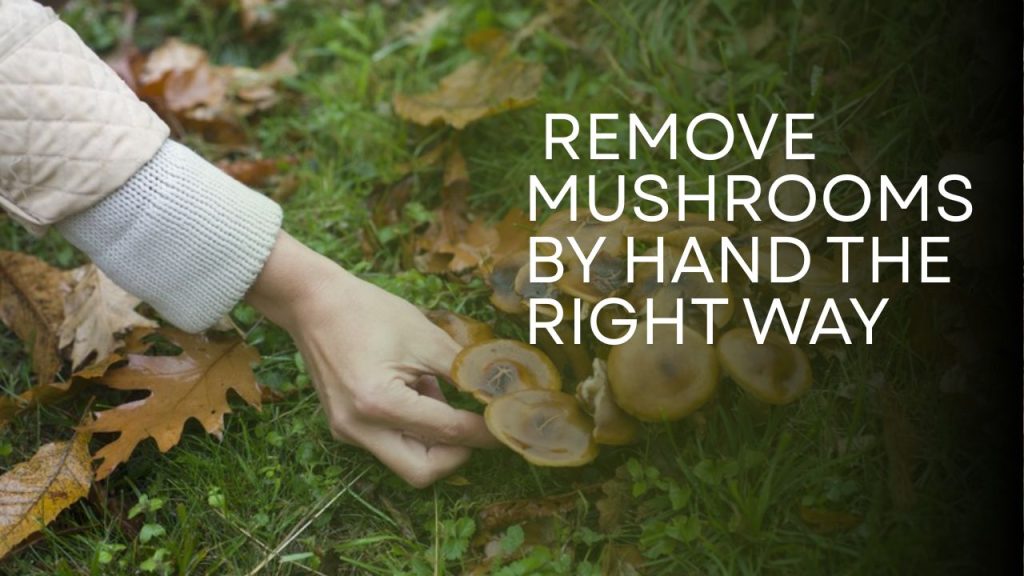Introduction
Mushrooms can pop up in your yard like uninvited guests. One day, the grass is green and clean; the next, you’ve got little fungi colonies squatting in your lawn like they own the place. While they’re not always bad, most folks want them gone—fast.
So, what do you do? Ignore them? Kick them down with your boot? Spray something and hope for the best? That won’t cut it. Getting rid of mushrooms the right way means more than just removing the cap.
Let’s break down four practical ways to clear mushrooms from your yard without turning your lawn into a science experiment.

Method 1: Remove Mushrooms by Hand the Right Way
First things first: don’t mow them. When you do that, you’re basically spreading spores like confetti. Those spores get cozy, wait for the right conditions, and boom—more mushrooms.
Instead, glove up. Grab a bag (paper or plastic works), and pluck the mushrooms at the base. Don’t just snap the caps; get the whole thing. Mushrooms grow from underground networks called mycelium. Removing the fruiting body won’t kill the mycelium, but it stops the spread for now.
Toss the mushrooms in the trash—never compost. That’s just giving them a second chance to cause trouble.
And one extra tip? Do this in the morning. Mushrooms are firmer and easier to remove when it’s cool.
Dive Deeper : How Early Can I Cut My Grass? A Practical Guide for Healthy Lawns
Method 2: Fix Drainage Issues to Prevent Mushrooms
Mushrooms love moisture. They thrive in damp, soggy spots where water hangs around too long after rain or watering. If parts of your lawn feel spongy or if puddles linger, that’s a flashing sign: poor drainage.
Check for low areas or places with compacted soil. You can fix these by aerating the lawn, adding topsoil, or even regrading in severe cases. French drains or dry wells can also help if you’re dealing with heavy runoff.
Also, don’t water at night. Water early in the morning, so the lawn has time to dry out. Fungi don’t like dry, sunny spots. Deprive them of what they love most: water.
Method 3: Adjust Soil pH to Discourage Fungi
Fungi prefer slightly acidic soil. If your pH is below 6.0, mushrooms feel right at home. You can check your soil’s pH with a test kit—cheap and easy to find at garden centers or online.
If it’s too acidic, sprinkle garden lime (not the fruit—calcium carbonate) over the area. This raises the pH and makes life harder for mushrooms. Follow the directions on the bag. Too much lime can throw off the balance and hurt your grass.
You won’t see instant results, but over time, your lawn becomes less inviting for fungi. Bonus: many grasses actually prefer a slightly alkaline environment. So you’re helping your lawn while making it harder for mushrooms to thrive.
Method 4: Use Safe Fungicides for Long-Term Control
If mushrooms keep coming back no matter what you try, you might need to bring out the big guns: fungicides. But not just any kind.
Go for pet- and kid-safe options. Products containing Bacillus subtilis or other microbial agents are good choices. These don’t just kill mushrooms—they help balance the soil.
Spray according to the label. Overuse can harm beneficial fungi and other organisms. And remember, fungicides treat the symptoms. They don’t cure the root cause. Pair this step with the others—especially fixing drainage and adjusting pH.
If you want an organic route, try neem oil. It’s natural, breaks down quickly, and has some antifungal punch.

How to Stop Mushrooms from Coming Back
Okay, you’ve removed the mushrooms and patched up the problem areas. But how do you keep them from popping up again?
Simple: change the environment.
- Rake up leaves and grass clippings. Mushrooms love decaying organic matter.
- Dethatch your lawn. A thick layer of thatch holds moisture and feeds fungi.
- Don’t overwater. Mushrooms don’t show up in dry, well-drained lawns.
- Keep an eye on tree roots. Decaying roots underground often lead to mushrooms above ground.
Also, don’t ignore the that random log or stump in the corner of your yard. Mushrooms treat that like an Airbnb.
It’s not about being perfect—just consistent. Mushrooms are opportunists. Don’t give them an opportunity.
Dive Deeper : How Long To Stay Off Lawn After Seeding: A Complete Guide
Are Yard Mushrooms Harmful? What You Should Know
Most yard mushrooms aren’t dangerous, but here’s the catch: some are. And unless you’re a trained mycologist, don’t gamble on guessing which is which. Some mushrooms can cause allergic reactions just from touching them. Others, if eaten, can cause anything from an upset stomach to something far worse.
Pets and kids are the main concern. Dogs, in particular, have a curious habit of munching on mushrooms. If you’re not sure what kind it is—bag it up and toss it. If you’ve got a lot of mushrooms showing up, it might also point to underlying rot—old tree roots, buried wood, or mulch breakdown. Worth a check.
Conclusion
Mushrooms in your yard aren’t the worst thing, but let’s be real—they’re not exactly welcome, either. They usually show up when there’s moisture, organic material, and the right soil. So, if you want them gone for good, don’t just yank them out. Change the environment.
Remove them by hand, fix those drainage issues, check your soil pH, and use safe fungicides when needed. More importantly, stay on top of yard care to stop them from coming back. You don’t need to declare war on mushrooms. But if you know how they work, you can make sure they pack up and leave—quietly.

